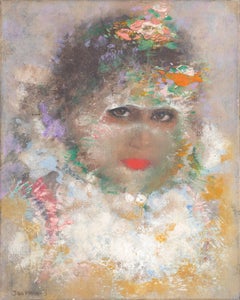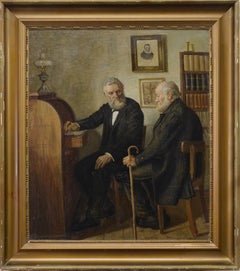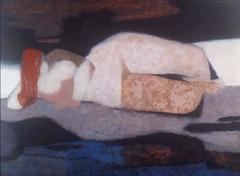Jan Hoowij Art
to
1
Overall Width
to
Overall Height
to
1
1
1
1
1
1
1
1
10,138
2,779
1,375
1,368
1
Artist: Jan Hoowij
'Young Woman', Grande Chaumière, Hague Academy of Fine Arts, Brooklyn Museum
By Jan Hoowij
Located in Santa Cruz, CA
An elegant oil portrait of a young Arab woman shown wearing a veil and gazing with candor and interest directly towards the viewer.
Signed lower left, "Jan Hoowij" (Dutch-American, ...
Category
1960s Jan Hoowij Art
Materials
Canvas, Oil
Related Items
1916 Danish Interior Genre Painting Conversation w Reverend Scene Framed Oil
Located in Stockholm, SE
Painting is signed for acknowledged artist Niels Holbak 1884-1954, who educated at the Art Academy in Finland 1909-10 and was taught at the Art Academy in Copenhagen from 1912-1914 a...
Category
1910s Realist Jan Hoowij Art
Materials
Canvas, Wood, Oil
$670
H 27.3 in W 24.2 in D 1 in
“North African Man, c. 1916-21” by Caleb Arnold Slade, American Portrait Oil
By Caleb Arnold Slade
Located in Yardley, PA
“North African Man, c. 1916-21” by Caleb Arnold Slade (American, 1882-1961)
Inspired by Slade’s travels in Algeria and Tunisia, this remarkable portrait depicts a young man standing...
Category
Early 20th Century American Impressionist Jan Hoowij Art
Materials
Canvas, Oil
$9,500
H 47.5 in W 40.25 in D 1.5 in
1975 Modernist Semi-Abstract Portrait Oil Painting - Figure in the Dark
Located in Bristol, GB
FIGURE IN THE DARK
Size: 49 x 40 cm (including frame)
Oil on canvas
An emotive and expressive semi-abstract figurative portrait, executed in oil onto canvas and dated 1975.
The co...
Category
Mid-20th Century Modern Jan Hoowij Art
Materials
Oil, Canvas
$991
H 19.3 in W 15.75 in
1830's French Romantic Period Large Oil Painting Christ on the Cross
By Eugène Delacroix
Located in Cirencester, Gloucestershire
The Crucifixion
French School, circa 1830's
circle of Eugene Delacroix (1798-1863)
oil on canvas, unframed
canvas: 37.5 x 22.5 inches
provenance: private collection, northern France
...
Category
Early 19th Century Romantic Jan Hoowij Art
Materials
Oil, Canvas
$2,119 Sale Price
30% Off
H 37.5 in W 22.5 in
Portrait of Civil War Union Sailor titled "Soldier"
Located in Fredericksburg, VA
Rick Reeves’ Soldier is a striking historical portrait that reflects the artist’s mastery of military realism and dedication to historical accuracy. Painted in alkyd oils, the work c...
Category
21st Century and Contemporary Contemporary Jan Hoowij Art
Materials
Canvas, Oil
Important Victorian portrait of Alexander Smith
Located in New York, NY
Important Victorian painting depicting Alexander Smith. It has a fantastic frame and is in excellent condition. Written Alex Smith (...) on the letter.
Category
Mid-19th Century Victorian Jan Hoowij Art
Materials
Canvas, Oil
Antique American Oil Painting Portrait Young Woman Necklace Period Frame Rare
Located in Buffalo, NY
A beautiful and rare antique American portrait of a young woman in a stunning period frame, likely original to the piece.
Unsigned but beaut...
Category
1890s American Realist Jan Hoowij Art
Materials
Canvas, Oil
$1,289
H 12 in W 10 in
Film Still #4 (portrait, western movie, cowboy, Hat, shadow, monochrome art)
By Rudolf Kosow
Located in Quebec, Quebec
With eyes obscured and hat lowered, this figure is both iconic and unknowable—a faceless cowboy adrift in a pale, open void. Kosow distills the visual codes of Americana and cinemati...
Category
2010s American Realist Jan Hoowij Art
Materials
Canvas, Oil
$1,560
H 11.82 in W 11.82 in D 0.99 in
Blackstone Cigars
By Norman Rockwell
Located in New Orleans, LA
A charming relic of a bygone era, this rare oil is the work of the inimitable American illustrator, Norman Rockwell. The iconic artist’s ability to render the details and nuances of ...
Category
Early 20th Century Other Art Style Jan Hoowij Art
Materials
Canvas, Oil
Catalan peasant oil on canvas painting spanish
By Luis Graner Y Arrufi
Located in Sitges, Barcelona
Oil mesures 36x23 cm.
Frameless.
Restored.
Category
1930s Modern Jan Hoowij Art
Materials
Canvas, Oil, Board
Mother and Children Ibiza Spain oil on canvas painting
By Ignacio Gil Sala
Located in Sitges, Barcelona
Title: Genre Scene with Mother and Children
Artist: Ignacio Gil Sala (Barcelona, 1913 – 2003)
Technique: Oil on canvas
Dimensions: 46 × 38 cm (18.1 × 15 in)
Signature: Signed at the ...
Category
1980s Post-Impressionist Jan Hoowij Art
Materials
Canvas, Oil
$2,639 Sale Price
26% Off
H 18.12 in W 14.97 in
Oil On Canvas Self Portrait of the artist Sir Anthony Van Dyck 18Th c
Located in Gavere, BE
"Oil On Canvas Self Portrait After Sir Anthony Van Dyck"
Follower of Sir Anthony van Dyck (Flemish painter, 1599-1641), Self portrait Oil on canvas (doubled),
Probably end 18th centu...
Category
Late 18th Century Baroque Jan Hoowij Art
Materials
Gold Leaf
$31,078
H 28.75 in W 25.2 in D 1.97 in
Previously Available Items
RECLINING NUDE
By Jan Hoowij
Located in Los Angeles, CA
JAN HOOWIJ
"RECLINING NUDE"
OIL ON PANEL, SIGNED
CALIFORNIA, C.1960
30 X 40 INCHES
Jan Hoowij
1907-1987
Jan Hoowij was born in Hengelo, Holland, and studied at t...
Category
1950s Modern Jan Hoowij Art
Materials
Masonite, Oil
Jan Hoowij art for sale on 1stDibs.
Find a wide variety of authentic Jan Hoowij art available for sale on 1stDibs. You can also browse by medium to find art by Jan Hoowij in canvas, fabric, oil paint and more. Much of the original work by this artist or collective was created during the 1960s and is mostly associated with the modern style. Not every interior allows for large Jan Hoowij art, so small editions measuring 13 inches across are available. Customers who are interested in this artist might also find the work of Etienne Ret, Patrick Procktor, and Maurice Kish. Jan Hoowij art prices can differ depending upon medium, time period and other attributes. On 1stDibs, the price for these items starts at $2,750 and tops out at $2,750, while the average work can sell for $2,750.



